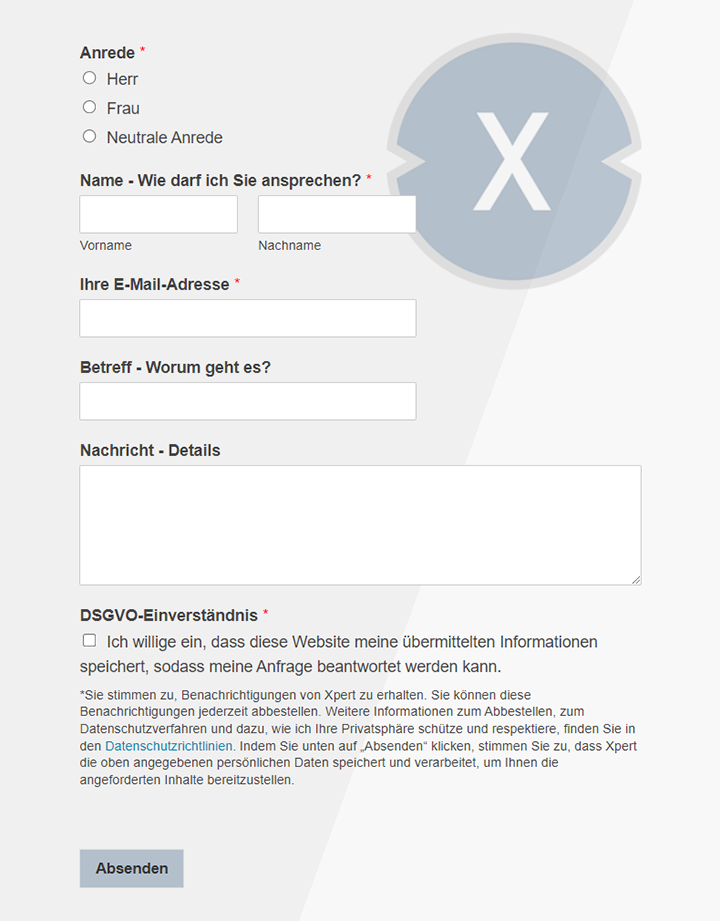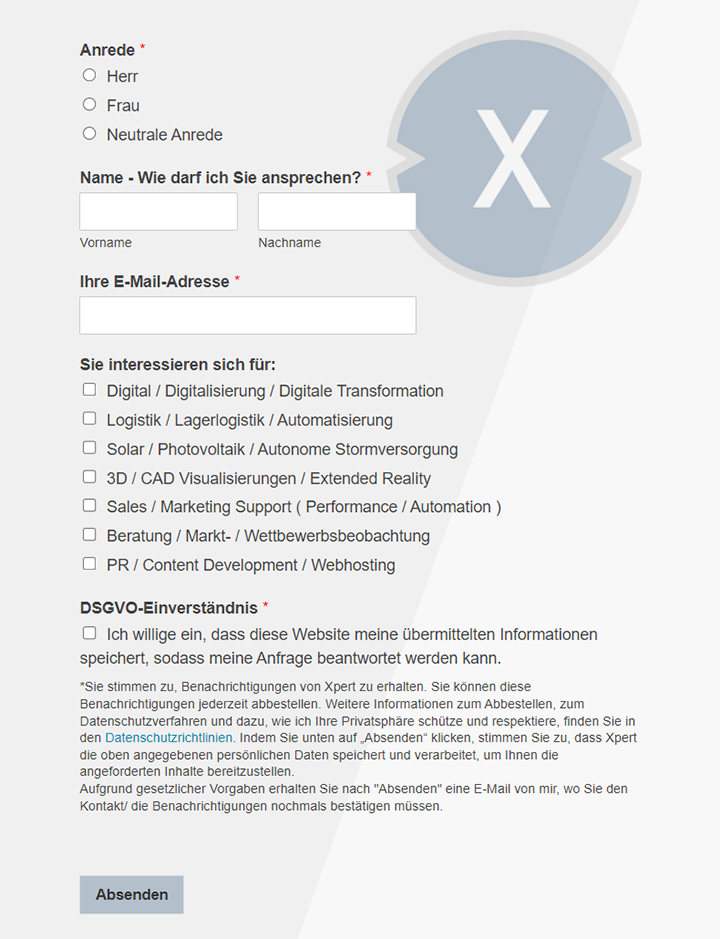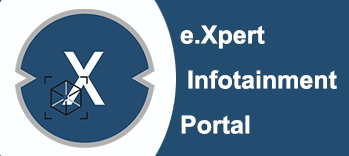30-50% unused digital work tools in marketing and sales-AI tools are also affected in addition to CRM and ERP
Xpert pre-release
Language selection 📢
Published on: April 15, 2025 / update from: April 15, 2025 - Author: Konrad Wolfenstein

30-50% unused digital work tools in marketing and sales-AI tools are also affected in addition to CRM and ERP-Image: Xpert.digital
From 50 to 100 percent: strategies for better use of digital resources (reading time: 31 min / no advertising / no paywall)
The unused potential of digital tools: potential for automation and process reliability in German companies
The digital transformation is progressing in German companies, but a paradox remains: While the adoption rates for digital work tools are high, a significant part of their potential, especially with regard to automation and security functions, remains unused. The estimate of only 30-50% in the user request probably reflects the use of advanced functions, not the basic use of the tools. This discrepancy between possession and actual value creation represents a significant, often overlooked chance. Existing tools such as CRM, ERP systems, collaboration platforms and increasingly also AI-based solutions provide considerable potential to increase process efficiency through automation and improve organizational resilience through increased process reliability.
📊 Many companies only use 30-50 % of their digital tools. Paradoxically, AI tools often remain unused
The analysis identifies central barriers that stand in the way of complete exhaustion of this potential. Above all, this includes qualification gaps and inadequate training measures, resistance to changes in the workforce, the complexity of the technologies itself, challenges in integration into existing IT landscapes as well as a lack of strategic focus and consistent support from management.
In order to close this gap and realize the full value of digital investments, companies have to pursue a multidimensional strategy. The core pillars are a human-centered change management, the establishment of a culture of continuous learning, the implementation of robust data governance structures-especially for AI applications-, ensuring seamless tool integration via APIs and an unmistakable commitment to the management level for digital development. The following recommendations offer companies a strategic framework to increase the intensity of use of their digital tools and thereby make significant progress in automation and process reliability.
Suitable for:
The status quo: use of digital and AI tools in companies
The digital penetration of the German corporate landscape has progressed well, but the pure availability of tools says little about their actual depth of use and the resulting added value. A closer look at adoption rates versus actual use reveals a significant gap.
Adoption vs. actual use: an inventory
The basic adoption of established digital office and business applications in Germany is impressively high. According to the Bitkom Digital Office Index 2024, almost all companies (98%) use ERP applications (Enterprise Resource Planning). CRM systems (Customer Relationship Management) are also widespread with 91%, a significant increase compared to 77% in 2022. Enterprise content management (ECM) solutions can be found in 84% of companies (2022: 76%). Each company uses at least one digital office solution. These figures show that access to standard digital tools in German companies is given nationwide and does not represent the primary obstacle.
In contrast, there is the adoption of artificial intelligence (AI). Although interest and willingness to invest are high - 40% of companies are planning to use AI next year, and 46% are planning investments in the next five years - the actual implementation is even significantly lower and more heterogeneous. In 2024, around 17% of German companies used AI. This shows a clear gap between sectors and corporate sizes: Industry is a pioneer with 31% AI use, while the service sector lags behind. The difference between large companies (75% use AI) and SME (only 16%) is particularly striking. International comparisons show similar trends: US studies locate the AI adoption at the company level, depending on the methodology, between 5% and 40%, but indicate rapid growth. Global indicate 40% of companies to use AI, another 42% evaluate the use. According to a McKinsey survey, KI uses over three quarters of the companies in at least one business function. This indicates that AI adoption gains driving, but is even less established and significantly more variable than with traditional digital tools.
The claim of a usage rate of only 30-50% raised in the user request must be considered in the context of these adoption data. It is unlikely that this number relates to the basic use of the widespread ERP or CRM systems. Rather, the evidence indicates that this estimate means the occupancy of advanced functions or the exhaustion of the full potential of the software. Gartner points out that insufficient user experiences with applications make it necessary to use digital adoption solutions (DAS). Studies and reports state that the potential of digital media is often not exhausted, especially in SMEs. A Muuuh Group study showed that 73% of the CRM users are not supporters of their own software, which indicates dissatisfaction, which is often related to the lack of usability or non-enrichment of the expected benefit. The initial premise of the low capacity is therefore valid, but most likely refers to the depth of use and the activation of more valuable but more complex features.
The perception of digitization in the company also has a part. While almost 40% of the employed in Germany classify their company as extremely or very digitally, a third of the catch -up requires the digital work organization, and 64% of companies see themselves as a straggler. This underlines the discrepancy between the pure availability of tools and their effective, transformative use. A significant part of the employees also does not feel sufficient for the necessary digital skills.
There are specific patterns when using AI. Employees use tools such as chatt more privately (54.3%) or mixed (27.8%) as exclusively for work (17.9%). The most common applications in companies are customer service (56%), cyber security (51%), digital assistants (47%), CRM (46%) and inventory management (40%). Although 75% of employees believe that generative AI can increase their productivity and that usage grows quickly, only 1% of managers describe the use of AI in their company as “mature”, ie completely integrated into workflows and deliver significant business results.
The loss of value: quantification of the missed opportunities
The substructure of digital tools leads to a significant loss of value and suboptimal return on investment (ROI) for massive expenses in the area of digital transformation. If automation functions remain unused, manual, inefficient processes persist. If integrated safety functions are not activated or configured, the risk of security incidents and compliance violations increases.
The unused productivity potential is considerable. Studies indicate measurable productivity increases through AI use, even with current, still low level of use (e.g. 0.1-0.9% growth of labor productivity). In the long term, the potential is estimated at 1.5 percentage points over ten years, and increases of 43% were measured in specific tasks. Provider of digital adoption solutions such as whatfix report productivity increases by 35% and a reduction in training by 60% by their platforms. These numbers illustrate the concrete value that can be raised by more effective tool use.
In addition, substructure is a strategic competitive risk. Companies that fully exhaust their digital tools and AI systems achieve higher efficiency, agility and innovative strength. You can react faster to market changes and develop new business models (“Composable Businesses” are 80% faster when implementing new features). Companies that remain in the basic use risk, risk losing connection and endanger their market position.
The analysis of the status quo thus reveals an “adoption illusion”: high implementation rates of core systems such as ERP and CRM suggest digital maturity, which, however, wears out profound substructure of advanced functions for automation and safety. This gap between presence and actual competence is the core problem. This pattern is reinforced in AI technologies. The AI adoption grows rapidly and harbors enormous potential, but the usage gap is probably even more pronounced due to higher complexity, data dependence, ethical concerns and greater qualification deficits than with traditional tools. The discrepancy between SMEs and large companies is particularly clear here. After all, there is often a discrepancy between the perception of employees regarding the digitization of their company and their own ability or the actual use of advanced tool functions. This misjudgment can hinder efforts to increase usage, since the need may not be recognized.
Suitable for:
- The sales paradox-forget the Sales Funnel: The Customer Journey is dead-despite AI, Automation and CRM!
Detect automation potential through deeper tool use
Many companies have already invested in powerful digital tools, but often only use a fraction of their automation skills. The fallow potential in CRM, ERP systems, collaboration platforms and AI tools is significant and can be lifted by targeted activation of existing functions.
Beyond the basics: overlooked workflow automation functions (CRM, ERP, collaboration platforms)
CRM automation
Modern CRM systems offer much more than just contact data management. Often unused functions include the automation of tasks (e.g. memories for follow-ups), the definition of workflow rules for the automatic assignment of leads or the escalation of service cases as well as the automated creation of reports on sales performance or customer satisfaction. Multi-channel communication automation makes it possible to consistently address customers via various channels (email, social media). Integration with other systems, such as ERP or marketing automation tools, is often available, but is not fully exploited to ensure seamless customer service and sales process. The reasons for the low use are often in poor implementation, lack of adaptation to specific processes or inadequate acceptance among users.
ERP automation
ERP systems are often used primarily for core functions such as financial accounting and resource planning, while further automation options are idle. Examples of this are the establishment of workflow automation for approval processes, for example for orders (Purchase Order Approvals), the automated processing of input calculations using OCR and rule-based assignment, or the optimization of the stock inventory management by automated order suggestions or warning messages at low stocks. The integration of the ERP system with other operational systems (CRM, supply chain management) is crucial for continuous process automation and transparency, but is often neglected. A common reason for the failure of ERP automation projects is the insufficient analysis and illustration of the underlying business processes before implementation.
Automation in collaboration platforms (M365/WorkSpace)
Leading collaboration suites such as Microsoft 365 and Google Workspace contain powerful but often overlooked tools for workflow automation:
- Google Workspace: Appsheet enables the creation of custom applications and the automation of workflows without programming knowledge. Google Forms can be used in conjunction with Google Sheets and Apps script for approval processes and simple workflows. Extended filters and rules in Gmail can automate e-mail management and AI-based functions in smart canvas (docs, sheets, slides) offer intelligent suggestions and building blocks to increase efficiency.
- Microsoft 365: Power Automats (formerly Flow) is a powerful tool for creating automated workflows across various Microsoft and third-party applications. SharePoint also offers integrated workflow functions, and the integration of power automatons in teams enables automation of notifications, permits and tasks directly in the collaboration hub. The seamless integration within the Microsoft ecosystem is an essential advantage.
NO code/low code platforms
The rise of no-code/low-code platforms that are often integrated into the large suites or are offered as independent solutions (e.g. Flowforma, Creatio, Kissflow, Jotform Workflows, Appsheet, Power Automats), democratizes automation. They enable specialist users to create their own automation solutions without deep programming knowledge. This can accelerate the automation efforts, but requires clear guidelines, training courses and a governance structure to avoid wild growth and risks.
Use AI for intelligent automation (data analysis, tasks support, process optimization)
Artificial intelligence raises traditional workflow automation to a new stage by bringing cognitive skills.
AI in the workflow automation
- Intelligent document processing (IDP): AI models can be relevant from unstructured documents such as invoices, documents, contracts or emails extract and classify, which drastically reduces manual data input.
- Predictive skills: AI can recognize patterns in historical data to predict future events. Examples are the predictive maintenance of machines (predictive maintenance), the forecast of demand and inventory or the identification of promising sales opportunities based on customer behavior.
- Intelligent forwarding and decision -making: AI can analyze the content and mood (sentiment) of customer inquiries in order to automatically forward it to the correct department or the right employee. It can also make more complex decisions within an automated process that goes beyond simple if-then rules.
AI assistant & agents
Integrated AI assistants (such as Microsoft Copilot, Google Gemini or Chatgpt Embedded functions) can automate or support a variety of tasks: You generate designs for emails, reports or marketing texts, summarize long documents or meetings together, answer employee questions on internal guidelines (HR, IT), help with scheduling or supporting data. So -called “Agentic Ai” goes one step further and can perform more complex, multi -stage tasks by using different tools and sources of information.
Robotic Process Automation (RPA) & intelligent automation
RPA denotes software robots (“bots”) that automate rule-based, repetitive tasks through the imitation of human interactions with user interfaces (e.g. copy data from one application to another). While classic RPA rely on structured data and clear rules, the combination with AI (often referred to as intelligent automation or hyper -automation) extends the possibilities significantly. AI enables RPA bots to process unstructured data (e.g. from emails or PDFs), to make context-related decisions and to learn from experience. Application examples can be found in almost all areas of the company:
- Finance: Automated reporting, comparison of accounts, fraud detection, invoice processing.
- Human Resources: employee onboarding/offboarding, salary billing, administration of vacation applications.
- Customer service: Automated answering standard inquiries via chatbots, forwarding of complex cases, updating customer data.
- Supplier & logistics: inventory management, order processing, optimization of delivery routes.
- Healthcare: processing of insurance claims, scheduling, administration of patient data.
- Production: order processing, quality control, supplier management.
Potential table
The following table shows an example of how often unused automation functions specific business processes assign and what advantages can be achieved.
Assignment of unused automation functions for business processes
In today's digital business world, there are numerous unused automation functions that can be strategically assigned to various business processes in order to achieve significant increases in efficiency. Workflow rules such as CRM permit rules for discounts can accelerate the sales cycle and ensure consistency in pricing, whereby platforms such as Salesforce, Microsoft Dynamics 365 or SAP CRM are used. NO code/low code platforms, such as power automates or appsheet for travel expenses, reduce the administrative effort and enable faster reimbursements through integration with Microsoft 365, Google Workspace, Flowforma or Creatio. The AI-based data extraction (IDP) revolutionizes automated accounting and document processing, which leads to faster payments and fewer input errors-implementable in ERP systems such as SAP and Oracle or specialized IDP tools with RPA+AI components. In the area of predictive analysis, AI solutions offer predictive maintenance warnings for production systems, which minimizes unplanned downtimes and maintenance costs can be reduced, supported by ERP/MES systems, IoT platforms and specialized AI solutions. Finally, AI assistants, Agentic AI and RPA technologies such as chatt/copilot for email designs or RPA for master data maintenance improve communication efficiency and reduce data input errors, implementable with M365 Copilot, Google Gemini, Uipath, Automation Anywhere or Blue Prism.
The analysis of the automation potential shows that a significant part of the possibilities are already in the tools, for which companies have already paid (CRM, ERP, M365/WorkSpace). The primary challenge is often not the purchase of new tools, but the activation and use of the existing, often powerful but overlooked functions. At the same time, the democratization of automation causes a paradox by NO code/low-code tools: It can accelerate the adaptation by enabling specialist users, but also harbors considerable risks without adequate governance, safety protocols and process standards [see section III and VI]. Finally, AI acts as an expansion layer: it not only automates existing tasks more efficiently, but also enables completely new forms of automation and process optimization through the processing of unstructured data, predictions and intelligent assistance, which is a qualitative jump in automation potential.
🎯📊 Integration of an independent and cross-data source-wide AI platform 🤖🌐 for all company matters

Integration of an independent and cross-data source-wide AI platform for all company matters-Image: Xpert.digital
Ki-Gamechanger: The most flexible AI platform-tailor-made solutions that reduce costs, improve their decisions and increase efficiency
Independent AI platform: Integrates all relevant company data sources
- This AI platform interacts with all specific data sources
- From SAP, Microsoft, Jira, Confluence, Salesforce, Zoom, Dropbox and many other data management systems
- Fast AI integration: tailor-made AI solutions for companies in hours or days instead of months
- Flexible infrastructure: cloud-based or hosting in your own data center (Germany, Europe, free choice of location)
- Highest data security: Use in law firms is the safe evidence
- Use across a wide variety of company data sources
- Choice of your own or various AI models (DE, EU, USA, CN)
Challenges that our AI platform solves
- A lack of accuracy of conventional AI solutions
- Data protection and secure management of sensitive data
- High costs and complexity of individual AI development
- Lack of qualified AI
- Integration of AI into existing IT systems
More about it here:
Maxify process reliability by AI and digital tools
Strengthening process reliability through extended tool functions
In addition to automation, digital tools and AI systems often offer unused functions to increase process reliability. The activation of these skills is crucial to minimize risks, to ensure compliance and to strengthen the resilience of business processes.
Use of extended access control and identity functions
Modern business applications and platforms go far beyond simple password logins and offer granular control mechanisms, which are often not fully configured or used. This applies to core systems such as ERP and CRM as well as to collaboration suites (M365, Google WorkSpace) and specialized access control systems (Access Control Systems, ACS).
Rol -based access control (RBAC)
A fundamental principle is the strict definition and enforcement of RBAC guidelines. It must be ensured that users can only access the data and functions that are essential for their specific role. Many systems offer tools to manage these roles, but the initial configuration and ongoing care require care and strategic planning. Tools such as BetterCloud can support the management of authorizations in cloud environments such as Office 365.
Identity life cycle management
A critical, often neglected aspect of security is the automation of the user management, in particular deprising. When employees leave the company or change their role, their access rights must be immediately and fully withdrawn. Integrated tools or identity management platforms can automate this process and minimize the risk of unauthorized access through outdated accounts. This is an area in which manual processes are prone to errors and can leave significant security gaps.
Multi-factor authentication (MFA) & context-related access
While MFA is increasingly becoming standard, many platforms offer extended, context -related access guidelines. These can restrict access based on factors such as the location of the user, the condition of the device used (Device Health) or the time of day and thus create an additional security level. Biometric verification methods (fingerprint, face recognition) can also be integrated to strengthen the identity examination.
Specialized access control systems (ACS)
Dedicated ACs are often used to secure physical locations and critical IT infrastructure. These systems offer hardware (e.g. card reader, controller) and software to manage physical and logical access. Important but sometimes overlooked aspects are the scalability of the solution in order to keep up with corporate growth, and the ability to integrate with other safety systems (e.g. video surveillance, alarm systems) for uniform security management.
Suitable for:
- AI for SEO-AI-based SEO tools and generative engine optimization (GEO): Comprehensive developments, technologies and practical examples
Use of integrated compliance and monitoring tools
Many platforms contain tools that can contribute to compliance with regulations and monitoring activities, but must be actively used and configured.
License management for security
The monitoring of license uses not only serves cost control, but is also an important safety factor. Inactive user accounts or non -used licenses represent potential attack vectors. The attack area can be reduced by identifying and deactivating these accounts. Specialized tools can help with the management and optimization of licenses.
Data Loss Prevention (DLP)
Platforms such as Microsoft 365 and Google Workspace have DLP functions that can identify and block the unintended or malicious parts of sensitive data (e.g. customer data, financial information, intellectual property) via email or cloud storage. However, these rules must be configured specifically for the needs and risks of the company in order to be effective.
Audit protocols and reporting
The use of integrated audit protocols is essential to understand user activities, system changes and access patterns. Many systems record these events in detail, but the protocols have to be checked regularly or, better still, forwarded to central security information and event management systems (SIEM) for automated analysis. The ability to track is essential for compliance and forensic studies.
Compliance functions
Tools can have specific compliance certifications. Governance platforms such as CoreView or Avepoint Cloud Governance help to enforce and monitor compliance guidelines within environments such as Office 365.
AI-supported security improvements
Artificial intelligence opens up new opportunities for proactive recognition and defense against security threats.
Anomaly detection
AI systems can learn what “normal” behavior is in a system or network, and deviations (anomalies) that could indicate safety incidents. Specific application cases include:
- Fraud recognition: Identification of unusual transaction patterns (e.g. high amounts, unusual places, quick frequency).
- Intrusion Detection: recognition of striking network traffic (e.g. data exiltration, DDOS attacks), suspicious registration tests or unusual user behavior.
- Endpoint security: tracking down malware or non -authorized activities on computers or mobile devices.
- IAM improvement: alarm for suspicious access requests, unusual authorization expansions or compromised accounts.
Threat intelligence & prediction
AI can analyze huge amounts of threat data (Threat Feeds) to prioritize relevant risks, to recognize attack patterns (TTPS - Tactics, Techniques, and Procedures) and even to predict future attacks or to identify weaknesses. AI can also be used to monitor the Dark Web on stolen access data or planned attacks.
Automated reaction to incidents
AI can automate the first steps to contain a safety incident, e.g. by isolating affected systems, blocking malignant IP addresses or deactivating compromised accounts, which shortens the response time.
Potential table
The following table often links unused security functions with specific risks that you can address.
Assignment of unused security functions for risk reduction
The assignment of unused security functions for risk reduction includes various functional categories, the specific examples and areas of application for relevant platforms and tools can be taken into account. In the area of access control, granular RBAC configuration offers support in preventing unauthorized access or data protection violations, which can be achieved, for example, with M365/Azure AD, Google Workspace Admin or ERP/CRM security settings. In addition to this measure, automated deprovisioning also makes a decisive contribution to minimizing continuing permissions and the associated insider risk, with IAM systems, HR system integrations as well as M365 or Google work space solutions.
In the compliance and surveillance category, configured DLP rules ensure protection against the drainage of sensitive data, which is supported by applications such as M365 Security & Compliance or the Google Workspace Security Center. Active audit log analysis also plays an important role in preventing compliance violations or a lack of traceability of processes. SIEM systems such as Splunk or Qradar as well as the log data of M365 and Google Workspace are valuable tools here.
In the area of AI security, AI-based anomaly recognition is used as a measure against account promotion and unauthorized penetration. This is achieved with the help of specialized AI security platforms or specific functions such as Azure Ad Identity Protection.
The analysis of the safety functions makes it clear that effective process reliability depends largely on the correct configuration and use of the features embedded in standard business applications (M365, WorkSpace, ERP, CRM). Subtracting these functions leads directly to security gaps, regardless of investments in dedicated security tools. At the same time, automation in both directions has an impact on safety: it can increase security (e.g. by automated deprising or patching), but poorly secured automation tools (e.g. RPA bots with too high rights, unregulated low-code apps) can become weak points themselves. This underlines the need to integrate safety aspects directly into the automation strategy. Finally, the effectiveness of AI-based security tools (anomali detection, threat forecast) is fundamentally dependent on the quality, completeness and governance of the underlying data. Bad data quality inevitably leads to unreliable AI security results (false alarms or overlooked threats), which underlines the critical role of data governance (see section VI).
Diagnosis of the usage gap: main barriers and challenges
In order to bridge the gap between the potential of digital tools and its actual use, it is crucial to understand the underlying obstacles. These can be roughly divided into human, technological and organizational factors.
The human factor: qualification deficits, lack of training and resistance
Qualification gaps & training
A lack of digital skills and inadequate training offers are one of the greatest hurdles. Employees often lack the knowledge of available functions or the ability to use them effectively. Almost three quarters of employees do not feel sufficient for the digital skills required at work. AI technologies tighten this problem with a steeper learning curve and the need for specialized know-how. Existing training courses are often inadequate, too short -term and do not offer continuous support in everyday work.
Resistance to change
The fear of the unknown, concerns about job security (especially in the context of AI and automation), the dislike of giving up established routines, and a lack of belief in the benefits of new tools or processes drive the resistance. This is mentioned as one of the top barriers. Inadequate communication on the part of management often increases these resistors.
Lack of user integration
If new tools are introduced without involving future users in the selection or implementation process, this often leads to a poor fit of the solution and low acceptance. The meaning and purpose (“why?”) The change must be clearly conveyed to users. User Acceptance Testing (UAT) phases often fail to capture the actual needs of the users if they are not carefully planned and carried out.
Cognitive overload & complexity
Employees are faced with a growing number of applications, which can lead to frictional losses and less use. The adaptation make it difficult to constantly or change tools and functions. The software itself can be inherently complex, less intuitive or poorly designed, which inhibits acceptance.
Technological hurdles: complexity, integration problems and old systems
Tool complexity
The software itself can make use of excessive complexity, illogical user interface or poor design. AI tools have additional technical complexity.
Integration challenges
Missing seamless integration between different tools leads to data silos, interrupted work processes and frustration among users. The integration of AI into existing system landscapes is a special challenge. The dependence on third-party integrations can hide additional risks. APIs are crucial for integration, but require specific know-how, and there is often a lack of uniform standards.
Alts systems (Legacy Systems)
Outdated IT infrastructure and old applications hinder the introduction of modern tools and brakes digital transformation initiatives. The migration of old systems is often complex and expensive.
Data problems
A lack of data quality, poor data availability and inadequate data governance are massive obstacles, especially for AI projects. Data protection and data security also represent considerable barriers for the AI adoption.
Selection of unsuitable tools
The decision for tools that do not match the actual business requirements or processes or the choice of an unsuitable provider often leads to the failure of the initiative.
Organizational factors: lack of strategy, lack of leadership support and resource shortage
Missing clear vision & strategy
The lack of a clear strategy for digital transformation, unclear objectives or a lack of orientation towards the overarching business objectives often lead to the failure of digitization initiatives. Many companies have a digital strategy on paper, but fail because of the implementation. A specific AI strategy in particular is often missing.
Inadequate leadership support
A lack of commitment, lack of visible support (sponsorship) and inadequate backing through the management level undermine transformation efforts. Managers may not live up to the desired behavior or have an inadequate understanding of the requirements themselves.
Resource restrictions
A lack of budget, time and staff- especially in qualified IT and AI specialists- is a significant barrier.
Organizational silos
Poor communication and lack of cooperation between different departments or teams hinder the integrated use of tools and difficult overarching transformation processes.
Lack of success measurement
Difficulties in the definition and persecution of key figures (KPIS) to measure the tool adoption, the increase in efficiency or the ROI make investments more difficult and control improvement measures.
Cultural aspects
Resistance to changes is often deeply rooted in corporate culture. A lack of innovation culture or inadequate data -driven thinking can hinder the introduction of AI.
Potential table
The following table summarizes the most common barriers that oppose optimal use of digital and AI tools.
Common barriers for the use of digital & AI tools
Common barriers for the use of digital and AI tools result from three main categories: the human factor, technological hurdles and organizational factors. Qualification deficits and lack of training play a central role in the human factor, which can lead to low competence, adoption and mistakes. In addition, resistance and fear of loss of job inhibit acceptance and delay progress. Technological hurdles include the complexity and unfriendliness of tools that cause frustration and inefficiency and thus impair use, as well as the lack of integration into existing old systems that cause data silos and process interruptions and hinder efficiency. At the organizational level, clear strategies are often missing, which misdirected efforts and resources are wasted. There is also a lack of management support, which can endanger projects because resources and support are missing. After all, resource restrictions such as time, money or personnel shortages often lead to project delays, overloads or even to demolish projects.
The analysis of the barriers shows that they rarely appear isolated, but form a complex, interlocking system. For example, a lack of management support often leads to an unclear strategy and underfunding of training measures. Inadequate training in turn exacerbated qualification gaps and increase fears and resistance. Complex tools without adequate training or change management inevitably lead to low acceptance. Technological problems such as lack of integration are often symptoms of poor planning and inadequate cross -departmental cooperation. A holistic approach is therefore essential.
A fundamental reason for the low use often lies in the “Why” deficit: It is not possible to clearly communicate and demonstrate the end users whose behavior is to change the concrete benefit and added value of the new tools or processes. If users do not recognize how a new tool makes their work easier or improves, the incentive to take the effort of learning is lacking, especially if the old routines work “good enough”.
In addition, the introduction of AI tightens the existing breaking points in adaptation of traditional digital tools. Challenges in the areas of qualifications, resistance, integration and strategy are increased by the additional complexity levels of AI (data requirements, ethics, costs, special talents). Companies that are already fighting with the basic digital adoption will find AI implementation even more difficult.
🎯🎯🎯 Benefit from Xpert.Digital's extensive, fivefold expertise in a comprehensive service package | R&D, XR, PR & SEM

AI & XR 3D Rendering Machine: Fivefold expertise from Xpert.Digital in a comprehensive service package, R&D XR, PR & SEM - Image: Xpert.Digital
Xpert.Digital has in-depth knowledge of various industries. This allows us to develop tailor-made strategies that are tailored precisely to the requirements and challenges of your specific market segment. By continually analyzing market trends and following industry developments, we can act with foresight and offer innovative solutions. Through the combination of experience and knowledge, we generate added value and give our customers a decisive competitive advantage.
More about it here:
Competence structure | Change Management: The key to successful digital transformation
Strategies to maximize the tool value: promotion of acceptance and competence
In order to overcome the barriers and to exploit the full potential of digital tools, targeted strategies are required that develop and support and support the skills of employees as well as organizational change.
Competence structure: modern training, retraining and continuous learning
Go beyond unique training
Successful tool uses require more than just initial introductory events. Continuous, role -specific and context -related learning offers are necessary, which grow with the software and needs of users.
User Acceptance Testing (UAT) as a learning chance
The UAT phase should not only be regarded as a technical test, but as an early opportunity for user training, feedback collection and to promote acceptance. Real end users should be integrated early and adequately prepared for their test tasks.
Effective training methods
A mix of different methods is often the most effective: structured courses, self-learning modules, train-the-trainer approaches, mentoring, well-kept knowledge databases and FAQs as well as context-sensitive help directly in the application (see DAPS). In the case of AI training, it is particularly important not only to convey the operation (“how?”), But also to address basic understanding (“What is/can/what is not?”), Ethical aspects and limits of technology.
Focus on benefits and workflow
Training should concentrate on how the tools solve concrete problems of the users and can be sensibly integrated into their daily work processes instead of only listing functions.
Strategy for competence development
Companies must address the general digital qualification gap through targeted upsky and rescilling programs.
Suitable for:
- Artificial intelligence: The path of island solutions to the integrated digital AI strategy using the example of Otto in e-commerce
Manage the human page: Effective change management and communication
Integrate change management early
Change management should be planned and carried out from the beginning of a project on project management. Prosci data show that excellent change management drastically increases the probability of success of projects.
Structured approach (e.g. Prosci Adkar)
Established models such as Adkar (awareness, desire, knowledge, ability, re -followed) offer a framework to systematically accompany individuals through the change process.
Clear communication strategy
A comprehensive communication plan is essential. It should provide regular, open, transparent information about different channels. Vision, goals, justification, schedule and effects on the employees must be clearly communicated. Consideration should be addressed proactively. The communication should ideally come from trustworthy senders (e.g. managers).
Minimize disorders
Negative effects on employees should be planned and cushioned. This includes the provision of resources and support as well as clarity about possible roles.
Encounter resistance constructively
The causes of resistance must be understood. The aim is to convert this through open communication, integration of those affected and the showing of advantages.
Secure acceptance: leadership support and employee qualifications
Active & Visible sponsorship
The decisive role of the top management level (C-Suite) cannot be emphasized enough. It must actively promote the change, communicate the vision, provide resources and show the desired behavior. Active sponsorship is the most important success factor for change initiatives.
Enable champions
So-called change champions or super users within the teams should be identified and enabled to support colleagues, offer informal training and act as multipliers.
User integration & feedback
Stakeholders, especially the end users, must be integrated early and continuously. Feedback should be actively caught up and used for improvement.
User centering
Design and implementation of new tools and processes must consistently focus on the actual needs of users and aim to improve their everyday work.
Technological support: The role of digital adoption platforms (DAPS)
Functionality of daps
DAPs are software solutions (e.g. whatfix, useful, pendo, walkmen) that are laid as an additional layer of existing applications. They offer context-sensitive instructions, interactive walkthroughs, help and onboarding support directly within the respective software.
Advantages
DAPS can accelerate onboarding, reduce training times and costs, reduce the number of support inquiries, increase application competence and provide usage analyzes. Gartner predicts that 70% of the organizations will use DAPS by 2025.
Role in change management
DAPS can serve as a tactical tool in change management by facilitating the acquisition of knowledge and skills (knowledge and ability in the ADKAR model) and promoting anchoring (purforcement) through continuous support.
Potential table
The following table summarizes proven practices to promote tool acceptance and competence.
Best practices to promote tool acceptance & competence
Best practices for promoting tool acceptance and competence include several strategic approaches. In the area of competence structure, continuous, role -specific training is essential to increase and promote skills. With change management, early and integrated change management is recommended to minimize resistance and uncertainties. Leadership and qualification play a central role, with active executive sponsorship ensures that both the necessary support and resources are guaranteed. At the same time, the integration of users is crucial by feedback loops to promote relevance and personal responsibility. At the technological level, the implementation of digital adoption platforms (DAP) or in-app aid supports the provision of on-demand support and the measurement of usage efficiency.
The analysis of the strategies for success shows that promoting tool use is a continuous process is not a one-off event. It requires continuous efforts in training, support, communication and reinforcement, far beyond the initial implementation. The leadership crystallizes as a linchpin: active, visible sponsorship through the company management is the most powerful factor that is most emphasized in order to overcome resistance and lead to success. Without this commitment, other efforts fizzle out easily. After all, technologies such as Daps can support adoption, but cannot replace a strategy. They are valuable tactical aids to impart knowledge and skills, but it is best to work in a comprehensive, well-planned change management and training strategy.
Lay the foundation: critical success factors
In order to ensure the advanced use of digital tools sustainably and to raise their full potential for automation and security, companies have to create a solid foundation from technological integration, data quality and organizational change ability.
Integration architecture: the importance of APIs and seamless connectivity
Silos open
One of the largest hurdles for efficient, automated processes are organizational and technological silos. A lack of integration between systems leads to manual data transmissions, redundancies and inefficiencies. A well thought-out integration strategy is therefore essential to enable seamless data flow and to implement end-to-end-end-process automation.
The role of APIS
Application Programming Interfaces (APIS) are the technological bridges that enable different software systems to communicate with each other and to automatically replace data. Well -documented, safe, reliable and standardized APIs are crucial for successful integration.
Advantages of integration
Successful integration offers numerous advantages: data is synchronized in real time across system boundaries, which improves data quality and consistency. It expands the possibilities of workflow automation, for example by linking CRM, ERP and marketing automation systems. Ultimately, a uniform data basis enables sound business decisions.
Integration strategy
Companies need a strategic approach to integration. This includes the careful selection of the right APIs, the consideration of factors such as costs, scalability, security and provider support as well as potentially the use of integration platforms (IPAAS) or specific tools such as the SAP Integration Suite or APIX-DRIVE to simplify the management of the interfaces. The success of integration efforts can often be measured directly to improvements in automation indicators such as cycle time reduction and error minimization.
Data as a fuel: Ensuring data quality and governance for KI & automation
Data are fundamental
Data is the “life elixir” of the AI and the basis for every effective automation. Bad data quality inevitably leads to bad results - the principle “Garbage in, Garbage Out” applies to a particular degree.
Definition of Data Governance
Data Governance refers to the overarching framework - consisting of guidelines, standards, processes and roles - to manage databases. The aim is to ensure the availability, usability, integrity and safety of the data throughout the company.
Meaning for AI/automation
High quality, well -managed data are essential for:
- Reliable AI models: reduction of distortions (bias), improvement of accuracy and structure of trust in the results.
- Effective automation: Ensure that automated processes are based on correct data and function as intended.
- Compliance: Compliance with legal regulations (e.g. GDPR/GDPR, CCPA).
- Security: Protection of sensitive data used for training AI models or in automated workflows.
Important governance practices
Central practices include the definition of data quality standards, their continuous monitoring and the establishment of processes for data adjustment. Also important are the management of metadata (often supported by data catalogs), clear access control rules, the management of the data life cycle, the definition of clear responsibilities (data ownership/stewardship), the tracking of the data origin and use (data lineage/provenance), a central management of guidelines and ensuring ethical data use.
AI for Data Governance
Interestingly, KI can be used to improve data quality and governance, for example by automating data adjustment, validation, monitoring and compliance tests.
Secure sustainability: anchor change management in the organization
Change as a permanent state
Digital transformation and the introduction of new tools are not completed projects, but a continuous process. Therefore, companies need permanently established ability to change change.
Develop internal maturity
Organizations should evaluate their own maturity in the area of change management and develop them further. This includes building skills, establishing standardized processes and promoting a culture that is positive about changes.
Integrate change management
Principles of change management should be firmly integrated into the daily processes, in project management methods and into the management practices.
Feedback loops & adaptation
It is crucial to establish continuous feedback loops in order to monitor acceptance, to recognize new challenges at an early stage and to adapt the strategies over time. Success should be measured and tracked using defined metrics.
The analysis of the success factors reveals a fundamental triangle: the successful, advanced use of digital and AI tools is based on the three dependent columns integration, data governance and change management. Weaknesses in one area undermine the stability of others. Advanced automation (section II) often requires cross -system data flow, which requires robust integration. The effectiveness of AI (Section II, III) depends critically on reliable, well -managed data. The implementation of these technical solutions and their successful adaptation by users in turn requires strong change management.
Data governance is not negotiable in particular for the increasing use of AI in order to build trust. The “Black Box” nature of many AI systems and their dependence on huge amounts of data create considerable risks (bias, data protection violations, errors) if the data is not carefully managed. Robust data governance is therefore essential to reduce these risks and to gain the trust of users and stakeholders that is necessary for the acceptance and use of AI-supported processes and knowledge.
After all, the ability to change develops into a competitive advantage. Organizations that build a mature, firmly anchored change management competence are better equipped to continuously adapt to technological progress and to draw sustainable value from their digital investments. You can adapt new tools, functions and processes faster and more effectively than competitors that fail on the adoption barriers described in Section IV.
Suitable for:
Potential of digital tools: How companies can maximize automation and security
The analysis has shown that despite the high adoption rates of digital tools in German companies, considerable potential for automation and process reliability remains unused. The often cited low load of 30-50% is likely to refer to advanced functions, whose activation promises significant efficiency gains and risk support. The barriers are diverse for this and include human factors such as qualification deficits and change resistance, technological hurdles such as complexity and integration problems as well as organizational defects such as a lack of strategies and lack of leadership support.
In order to conclude this gap and to implement the full value of digital investments, including AI, a strategic, holistic approach is required. This must combine the competence structure of employees, professional change management and strong leadership with the creation of technical and data -related basics (integration, data governance).
Recommendations for action for managers
- Mandate for a usage analysis: Commission a formal evaluation of how central digital and AI tools are actually used in comparison to their potential. The focus should be on automation and security functions. Use analysis tools or DAPs for data collection where possible.
- Prioritization of function activation before buying a new acquisition: First, focus on maximizing the value of existing platforms through targeted training, process adjustments and the configuration of unused functions before further investments are made in new tools.
- Establish change management as a strategic priority: invest in the structure of internal change management skills and integrate them into all digital initiatives right from the start. Make active, visible sponsorship through the management level for significant changes.
- Put on continuous learning and support programs: go beyond unique training and establish role-specific, continuous learning paths. If necessary, support this by DAPS and focus on the application in the workflow and the concrete benefit.
- Establish robust data governance (especially for AI): Implement a clear data governance frame with defined roles, guidelines and quality standards as a basic requirement for the reliable and ethical scaling of AI initiatives.
- Develop strategic integration roadmap: Invest in a clear API strategy and potentially in integration platforms to break down data silos and enable the data flow critical for automation.
- Promote the culture of user feedback and ability: Create mechanisms for continuous feedback from users and include them at an early stage in the definition of needs and testing solutions (apply best practice for uat).
- Measure what matters: Define clear key performance indicators (KPIS) for tool use, efficiency gains in processes, improvements in security as well as for the competence and satisfaction of the users to pursue progress and prove the ROI.
By consistently implementing these recommendations, companies can close the gap between the potential of their digital tools and their actual use and thus make significant progress in the automation of processes and strengthening their security.
We are there for you - advice - planning - implementation - project management
☑️ SME support in strategy, consulting, planning and implementation
☑️ Creation or realignment of the AI strategy
☑️ Pioneer Business Development
I would be happy to serve as your personal advisor.
You can contact me by filling out the contact form below or simply call me on +49 89 89 674 804 (Munich) .
I'm looking forward to our joint project.
Xpert.Digital - Konrad Wolfenstein
Xpert.Digital is a hub for industry with a focus on digitalization, mechanical engineering, logistics/intralogistics and photovoltaics.
With our 360° business development solution, we support well-known companies from new business to after sales.
Market intelligence, smarketing, marketing automation, content development, PR, mail campaigns, personalized social media and lead nurturing are part of our digital tools.
You can find out more at: www.xpert.digital - www.xpert.solar - www.xpert.plus


































